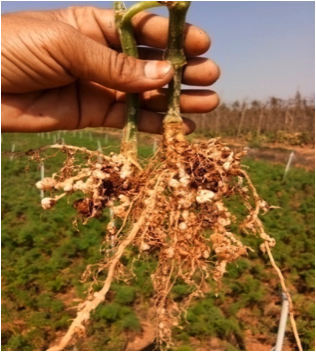Root-knot nematode, Meloidogyne incognita
Root knot nematode, Meloidogyne incognita is a obligate, sedentary endoparasites.
M. incognita is one of the major constraints in the production of tomato in tropical and subtropical regions. It causes 11 – 35% yield loss in tomato. Root knot remains a serious issue in both nursery and field conditions.
Mode of spread
Seedlings or planting materials, irrigation water and farm implements.
Symptoms
Above ground symptoms
-
Infested seedlings may not survive after transplanting.
-
Stunted growth of the plants.
-
Disease appearance in patches under field conditions.
-
Leaves show chlorosis and yellowing.
-
Growth may be retarded.
-
Plants show “Day wilting” symptom.
Below ground symptoms
-
Primary galls are small and induced by swelling which coalesce to form larger secondary gall s/ knots on the root.
-
Root system is reduced to a severely galled and a completely disorganized vascular system.
-
Sometimes the galled tissues are invaded by secondary pathogens and results in root wilting.
 Root knot galls on tomato
Root knot galls on tomato |

